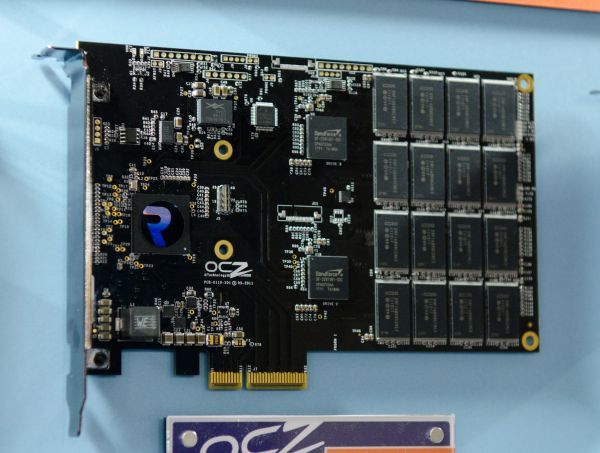Computex 2011: OCZ's RevoDrive 3 & RevoDrive 3 X2, Now With TRIM
by Anand Lal Shimpi on May 31, 2011 9:59 AM EST- Posted in
- Trade Shows
- SSDs
- SandForce
- OCZ
- SF-2000
- RevoDrive 3
- Computex 2011
There's a new PCIe SSD in town: the RevoDrive 3. Armed with two SF-2281 controllers and anywhere from 128 - 256GB of NAND (120/240GB capacities), the RevoDrive 3 is similar to its predecessors in that the two controllers are RAIDed on card. Here's where things start to change though.
In the past OCZ used a PCI-X RAID controller to keep costs down, but that's now gone. OCZ won't disclose the name of the controller vendor but a quick look at the card shows that it's native PCIe. The RevoDrive 3 itself is a PCIe 2.0 x4 card, however OCZ wouldn't confirm whether or not the controller was running at 2.0 or 1.0 speeds - just that the interface wasn't a bottleneck.
The other big improvement is that OCZ made some modifications to both the SandForce and on-board RAID controller firmware to allow everything from SMART data to TRIM to be passed through to the system host. In the past RevoDrive users were stuck with a PCIe card that couldn't be TRIMed, but with the 3 you get full TRIM support. Formatting the drive under Windows 7 or deleting files off of will result in those LBAs being TRIMed by the SF controllers.
OCZ is promising up to 900MB/s reads and 700MB/s writes (highly compressible of course). Random writes are spec'd at up to 120,000 for 4KB transfers. OCZ expects the 240GB capacity to sell for $599.
In addition to the standard RevoDrive there's an X2 version with twice the controllers:
With four controllers the RevoDrive 3 X2 is good for up to 1.5GB/s reads and 1.2GB/s writes. OCZ is quoting up to 200,000 4KB random write IOPS. Again all of these figures are using highly compressible data. Just like the base RevoDrive 3, TRIM/SMART reporting are now supported on the x2.
Capacities start at 240GB ($699) and go all the way up to 960GB.


















23 Comments
View All Comments
Wardrop - Wednesday, June 1, 2011 - link
I believe he's referring to sequential read/write performance of incompressible data. The figures you quoted are maximum speeds, which would only be obtainable if writing highly compressible data. Most recent respectable benchmarking applications write incompressible data, hence if 360MB/s is the speed at which this drive writes incompressible data, then GullLars's maths is correct, and yours is wrong.And even if you did get 1.2GB/s write performance, that doesn't mean 1.2GB/s is being written to NAND. If the data is highly compressible, then it's likely only a fraction of that is being written, possibly well under the 360MB/s mentioned by GullLars.
Olternaut - Tuesday, May 31, 2011 - link
So where does HSDL fit in this equation?Any word on that Anand?
marraco - Tuesday, June 28, 2011 - link
Tomshardware published a complete review this morning, I read the first pages, made an hour pause, and returned for the remaining pages, but the article was removed :(